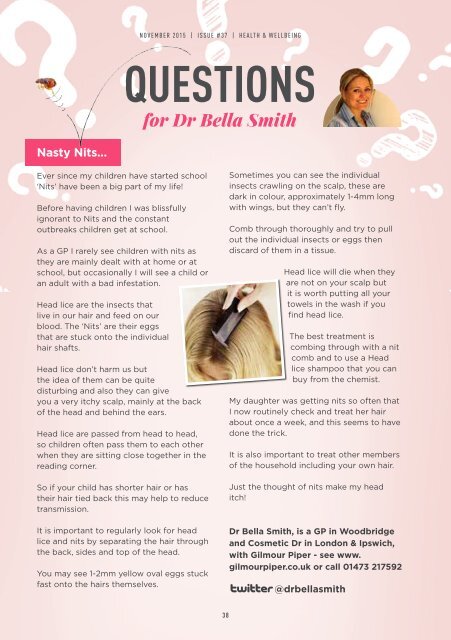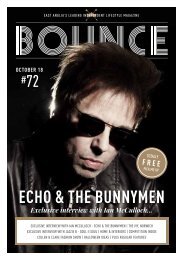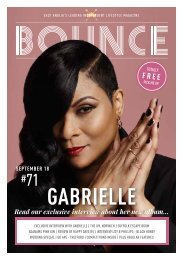Bounce Magazine November 2015
Featuring an exclusive interview with Rick McMurray from Ash, review at Upstairs at Baileys, Bounce wins award, Christmas Shopping Ideas and First Times.
Featuring an exclusive interview with Rick McMurray from Ash, review at Upstairs at Baileys, Bounce wins award, Christmas Shopping Ideas and First Times.
You also want an ePaper? Increase the reach of your titles
YUMPU automatically turns print PDFs into web optimized ePapers that Google loves.
NOVEMBER <strong>2015</strong><br />
NOVEMBER<br />
| ISSUE<br />
<strong>2015</strong><br />
#37 | HEALTH<br />
ISSUE #37<br />
& WELLBEING<br />
QUESTIONS<br />
for Dr Bella Smith<br />
Nasty Nits...<br />
Ever since my children have started school<br />
‘Nits’ have been a big part of my life!<br />
Before having children I was blissfully<br />
ignorant to Nits and the constant<br />
outbreaks children get at school.<br />
As a GP I rarely see children with nits as<br />
they are mainly dealt with at home or at<br />
school, but occasionally I will see a child or<br />
an adult with a bad infestation.<br />
Head lice are the insects that<br />
live in our hair and feed on our<br />
blood. The ‘Nits’ are their eggs<br />
that are stuck onto the individual<br />
hair shafts.<br />
Head lice don’t harm us but<br />
the idea of them can be quite<br />
disturbing and also they can give<br />
you a very itchy scalp, mainly at the back<br />
of the head and behind the ears.<br />
Head lice are passed from head to head,<br />
so children often pass them to each other<br />
when they are sitting close together in the<br />
reading corner.<br />
So if your child has shorter hair or has<br />
their hair tied back this may help to reduce<br />
transmission.<br />
It is important to regularly look for head<br />
lice and nits by separating the hair through<br />
the back, sides and top of the head.<br />
You may see 1-2mm yellow oval eggs stuck<br />
fast onto the hairs themselves.<br />
Sometimes you can see the individual<br />
insects crawling on the scalp, these are<br />
dark in colour, approximately 1-4mm long<br />
with wings, but they can’t fly.<br />
Comb through thoroughly and try to pull<br />
out the individual insects or eggs then<br />
discard of them in a tissue.<br />
Head lice will die when they<br />
are not on your scalp but<br />
it is worth putting all your<br />
towels in the wash if you<br />
find head lice.<br />
The best treatment is<br />
combing through with a nit<br />
comb and to use a Head<br />
lice shampoo that you can<br />
buy from the chemist.<br />
My daughter was getting nits so often that<br />
I now routinely check and treat her hair<br />
about once a week, and this seems to have<br />
done the trick.<br />
It is also important to treat other members<br />
of the household including your own hair.<br />
Just the thought of nits make my head<br />
itch!<br />
Dr Bella Smith, is a GP in Woodbridge<br />
and Cosmetic Dr in London & Ipswich,<br />
with Gilmour Piper - see www.<br />
gilmourpiper.co.uk or call 01473 217592<br />
t@drbellasmith<br />
38<br />
38


















